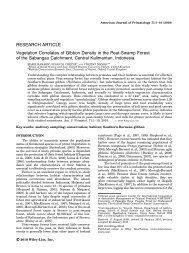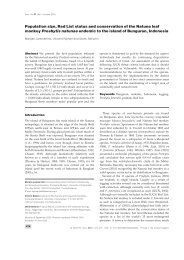Seasonal variation in naturally occurring mobbing ... - Vincent Nijman
Seasonal variation in naturally occurring mobbing ... - Vincent Nijman
Seasonal variation in naturally occurring mobbing ... - Vincent Nijman
Create successful ePaper yourself
Turn your PDF publications into a flip-book with our unique Google optimized e-Paper software.
28 V. <strong>Nijman</strong><br />
dry (or less wet) season. Given an <strong>in</strong>cubation period of about 16-17 days, and a nestl<strong>in</strong>g period<br />
of about 17-18 days (data from D. adsimilis: FREY et al. 2000), and while acknowledg<strong>in</strong>g<br />
the occurrence of nests at all times of the year, the period April-August was considered the<br />
breed<strong>in</strong>g season for drongos on Java and, subsequently, September-March as the non-breed<strong>in</strong>g<br />
period.<br />
I used a log-likelihood analysis (G-test) to test for differences <strong>in</strong> the distribution of<br />
occurrences, with the expected values generated based on a random distribution proportional<br />
to sampl<strong>in</strong>g effort per species or season (cf. NIJMAN & VAN BALEN 2003). To obta<strong>in</strong> a better<br />
approximation to χ 2 William’s correction to G was applied (G adj : SOKAL & ROHLF 1995). G adj<br />
values were compared with critical values of the χ 2 distribution. Significance was assumed<br />
when P < 0.05 <strong>in</strong> a two-tailed test.<br />
RESULTS<br />
Differential mobb<strong>in</strong>g by drongos towards avian predators<br />
Mobb<strong>in</strong>g of one of the two species of eagle by one of the two species of drongo<br />
was a relatively rare occurrence, and especially those mobb<strong>in</strong>g attempts that<br />
<strong>in</strong>volved physical contact. In all, I documented 27 mobb<strong>in</strong>g attempts by drongos<br />
that <strong>in</strong>cluded an attack with physical contact, i.e. 17 towards Javan hawk-eagles<br />
and 10 towards black eagles. Ten attacks were performed by ashy drongos and 7 by<br />
black drongos. For 10 attacks the birds were not identified to the species level but<br />
were by either ashy or black drongos (and not one of the two other species of<br />
(racket-tailed) drongo present <strong>in</strong> the study areas). All but one of the attacks were<br />
towards fly<strong>in</strong>g eagles; once a black eagle perched <strong>in</strong> a tree was attacked for several<br />
25<br />
20<br />
Black Drongo<br />
Ashy Drongo<br />
Total<br />
N (nest)<br />
15<br />
10<br />
5<br />
0<br />
J F M A M J J A S O N D<br />
Month<br />
Fig. 1. — The breed<strong>in</strong>g season of Dicruridae (black drongo Dicrurus macrocercus [N = 33], ashy<br />
drongo D. leucophaeus [N = 47]) <strong>in</strong> western Java, Indonesia based on the number of nests observed<br />
per month (data from HOOGERWERF 1949 and HELLEBREKERS & HOOGERWERF 1967). Months dur<strong>in</strong>g<br />
which a nest was found but no eggs were collected were <strong>in</strong>cluded conservatively as a s<strong>in</strong>gle nest<strong>in</strong>g<br />
attempt.










